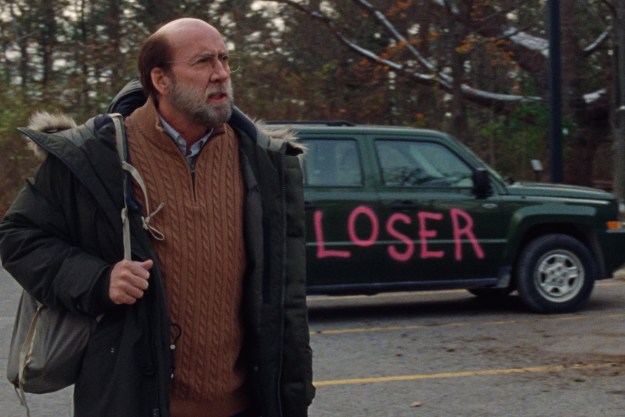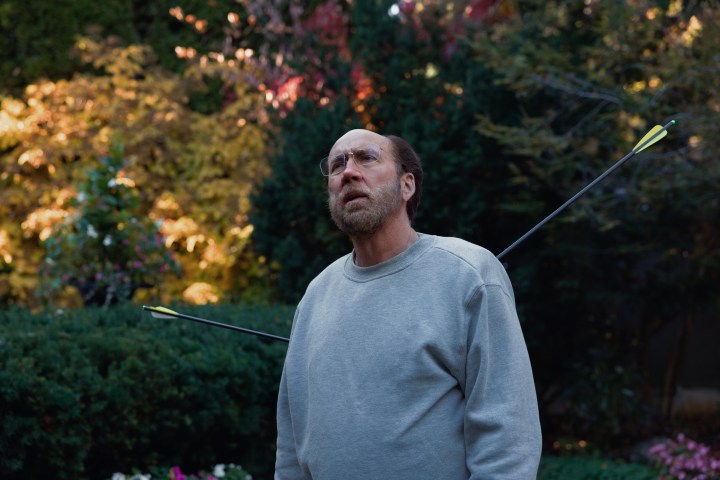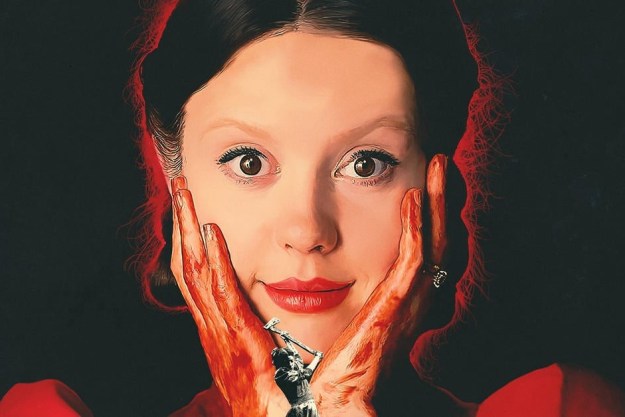
“A24's Dream Scenario scores points for being original in execution, but it doesn't really have anything new to say.”
- Nicolas Cage's perfectly over-the-top performance
- Several inspired dream sequences
- Michael Cera and Julianne Nicholson's standout supporting turns
- Repetitive second and third acts
- A finale that just barely misses the mark
“How does it feel to go viral?”
It’s fitting that this question is posed so early in Dream Scenario, a film that treats fame as much like a disease as it does a curse. Produced by Ari Aster and distributed by A24, the new movie from writer-director Kristoffer Borgli is a decidedly modern nightmare comedy, one that’s practically overflowing with its own notions about everything from Cancel Culture to the kind of insidious viral marketing techniques that are designed to capitalize on every odd story that gains attention online. For a film that frequently veers into the surreal realm of the subconscious, Dream Scenario’s focus is unwaveringly trained on the real-life costs of achieving a certain level of public notoriety in the 21st century.
Like Aster’s Beau is Afraid, the film is heavily indebted to the works of both Charlie Kaufman and Joel and Ethan Coen, whose respective filmographies include some of America’s greatest, Kafkaesque nightmare comedies (see: A Serious Man, Being John Malkovich). Unlike the Coens and Kaufman’s films, though, Dream Scenario never achieves a level of emotional introspection or insight to become anything more than an occasionally hilarious, frequently frustrating comedy. It’s a film that has a lot on its mind, but very little new to say.

While it fails to enter the canon of Great Neurotic Comedies, Dream Scenario does succeed as a showcase for its oft-venerated star, Nicolas Cage. The Oscar-winning actor leads the film as Paul Matthews, a tenured college professor who lives a relatively quiet life with his wife, Janet (Julianne Nicholson), and their two young daughters. A social and professional outcast, Paul is plagued by his own inability to stand out. That fact is made abundantly clear in one painfully observant early scene that sees him accuse a former classmate of stealing some of his academic ideas only to become flustered when she notes in return that he’s never actually put in the effort to get any of his work published.
Paul’s existence is turned upside down when he begins appearing inexplicably in other peoples’ dreams. The strange phenomenon turns him into an overnight star and provides him with the attention he’s long wanted. However, while both he and Janet initially use his viral fame to further their own careers and professional profiles, their lives take a turn for the worse when everyone’s dreams involving Paul transform into terrifying, often violent nightmares. Unnerved by his behavior in their dreams, Paul’s many students, colleagues, and anonymous admirers quickly turn on him — elevating him from a quirky celebrity to a universally loathed pariah.
It is, notably, when Paul’s lucky streak vanishes that Dream Scenario begins to seem less and less surefooted. For most of its first half, the film is able to maintain a delightfully zany, lighthearted tone. While Paul’s cameos in so many others’ dreams give him the public recognition that he’s craved for so long, too, Borgli’s screenplay playfully and ironically establishes the fact that his sudden power and influence aren’t enough to make him the man he desperately wants to become. The gulf between who we want to be and who we really are is often painfully greater than any of us would like to admit, and Dream Scenario is at its most compelling when it explores that gap.

As Paul, Cage is a balding, jittery mess. Overwhelmed and undercut by his own social ineptitude, he’s a constantly grinning vessel of pure cringe. Cage, for his part, adds to his recent streak of memorable late-career turns by leaning all the way into Paul’s neuroses. His performance is both cartoonishly over-the-top and deeply felt — a wholehearted embracement of his character’s ugliness and a full-throated refusal to shy away from or tamp down his most embarrassing qualities. The actor’s work throughout the film only makes the moments in Dream Scenario’s first half when his character falls short of his expectations for himself all the more hilarious and agonizing.
Once the film shifts its focus away from its lead’s many shortcomings and more toward its ideas about the unforgiving aspects of Cancel Culture, its effectiveness quickly begins to plummet. The second half of Borgli’s screenplay is packed to the brim with scenes that feel purposefully ripped from certain online headlines, but no matter how scathing the filmmaker’s criticisms of mob mentality are, they’re still infinitely less interesting than the internal conflict raging within Cage’s Paul. The film inevitably becomes less engaging the more that Paul’s unlucky breaks begin to feel genuinely out of his control, rather than the inevitable results of his frequent missteps and blindingly apparent faults.

By the time it’s reached its epilogue, Dream Scenario has already introduced more underbaked pieces of social criticism, some of which have little to nothing to do with the themes present throughout the film’s first two-thirds. As entrancing and purposefully jarring as Borgli’s visual approach to Dream Scenario often is, the comedy ultimately isn’t able to bring all of its ideas together in a satisfying fashion. In its final moments, the film indulges in a sequence that is charming in both its open-faced silliness and its understated sweetness, but which doesn’t send it out on a note that’s sufficiently acidic, moving, or funny. It’s a film that, despite its occasionally inspired moments of wonder and absurdity, fails to live up to its own aspirations.
Dream Scenario is now playing in theaters.
Editors' Recommendations
- 5 best horror movies of 2023 so far
- Decision to Leave review: An achingly romantic noir thriller
- Tár review: Cate Blanchett soars in Todd Field’s ambitious new drama
- God’s Creatures review: an overly restrained Irish drama
- Blonde review: a striking and tough Marilyn Monroe biopic




